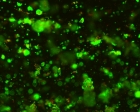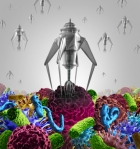Press monitoring
Material uses live cyanobacteria to neutralize waterborne pollutants
6.9.2023 | Press monitoring
We often hear of cyanobacteria as being the cause of toxic blue-green algae blooms in lakes and rivers. Soon, however, a 3D-printed material that incorporates the microbes could be used to help purify polluted water – and after the bacteria are finished, they'll kill themselves. Developed by a team of scientists at the University of California...
Vaccines to prevent fentanyl, heroin overdose close to human trials
4.9.2023 | Press monitoring
Opioids – especially synthetic opioids – are the main driver of drug-related overdose deaths. The availability of drugs like heroin and fentanyl continues to feed the problem of opioid dependence and places users at risk of death. They’re also difficult drugs to quit. While the streets are unlikely to ever be clear of drugs like heroin and...
Waste colonies yield bacterium with 3 enzymes that may break down polyester
1.9.2023 | Press monitoring
Scientists have enriched expanded polystyrene waste from a beach in Ireland to isolate a bacterium shown to contain three enzymes that could break down polyester. The team, from Brunel University London, is studying microorganisms that can degrade plastic, in the hope the microorganisms or their plastic-degrading enzymes can be used to manage the...
Titanium micro-spikes skewer resistant superbugs
30.8.2023 | Press monitoring
A new study suggests rough surfaces inspired by the bacteria-killing spikes on insect wings may be more effective at combating drug-resistant superbugs, including fungus, than previously understood. To avoid infection around implants – such as titanium hips or dental prosthesis – doctors use a range of antimicrobial coatings, chemicals and...
Novel treatment for myocardial infarction uses nanovesicles to modulate immune response
28.8.2023 | Press monitoring
Myocardial infarction is an ischemic heart disease in which the coronary arteries – the blood vessels that supply blood to the heart – become narrowed or blocked, resulting in insufficient blood supply to the heart muscle, which causes nutrient and oxygen deficiency in the myocardium, leading to poor heart function. Dr. Yoon Ki Joung and Dr. Juro...
Tiny magnetic beads produce an optical signal that could be used to quickly detect pathogens
25.8.2023 | Press monitoring
Getting results from a blood test can take anywhere from one day to a week, depending on what a test is targeting. The same goes for tests of water pollution and food contamination. And in most cases, the wait time has to do with time-consuming steps in sample processing and analysis. Now, MIT engineers have identified a new optical signature in...
Longevity gene from naked mole rats extends lifespan of mice
23.8.2023 | Press monitoring
In a groundbreaking endeavor, researchers at the University of Rochester have successfully transferred a longevity gene from naked mole rats to mice, resulting in improved health and an extension of the mouse's lifespan. Naked mole rats, known for their long lifespans and exceptional resistance to age-related diseases, have long captured the...
Hookworms successfully prevent type 2 diabetes in human trial
21.8.2023 | Press monitoring
In a world first, a two-year human trial conducted by James Cook University (JCU) has wound up, and the worms graduated with flying colors, particularly in relation to type 2 diabetes, paving the way for a larger international trial. What’s more, of the 24 participants who received worms, when offered a dewormer at the end of the second year of...
Deconstructing the bee stinger to develop tiny, bio-inspired medical devices
18.8.2023 | Press monitoring
New research deconstructing the anatomy of a honeybee stinger could help pave the way for a future generation of miniaturized medical devices used for drug delivery in humans. Published in the journal iScience, the high-resolution 3D deconstructions produced by University of New South Wales Canberra researchers reveal the unique properties of the...
Nanozymes drive tumor-specific drug delivery while minimizing toxicity
16.8.2023 | Press monitoring
Chemotherapy is a mainstay of cancer treatment. While effective, this therapy indiscriminately kills rapidly dividing cells – cancerous or otherwise – so patients frequently experience severe side effects, ultimately limiting its utility. But what if there was a way to administer an inactive chemotherapeutic throughout the body and 'turn on'...
































